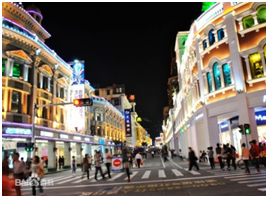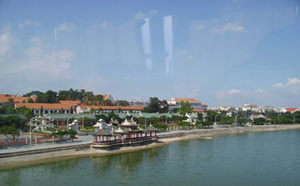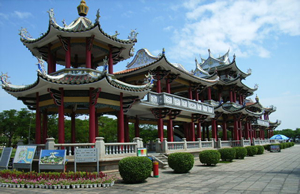鼓浪屿 / Gulang Islet
 鼓浪屿是全国文明风景旅游区示范点,位于福建省厦门市西南隅,与厦门岛隔海相望。原名圆沙洲、圆洲仔,因海西南有海蚀洞受浪潮冲击,声如擂鼓,明朝雅化为今名。由于历史原因,中外风格各异的建筑物在此地被完好地汇集、保留,有“万国建筑博览”之称。龙头路商业街还有张三疯奶茶、赵小姐店铺、三老肉脯干等诸多火热商铺,小岛还是音乐的沃土,人才辈出,钢琴拥有密度居全国之冠,又得美名“钢琴之岛”、“音乐之乡”。
鼓浪屿是全国文明风景旅游区示范点,位于福建省厦门市西南隅,与厦门岛隔海相望。原名圆沙洲、圆洲仔,因海西南有海蚀洞受浪潮冲击,声如擂鼓,明朝雅化为今名。由于历史原因,中外风格各异的建筑物在此地被完好地汇集、保留,有“万国建筑博览”之称。龙头路商业街还有张三疯奶茶、赵小姐店铺、三老肉脯干等诸多火热商铺,小岛还是音乐的沃土,人才辈出,钢琴拥有密度居全国之冠,又得美名“钢琴之岛”、“音乐之乡”。
Gulangyu Island is located just southwest of Xiamen City. Visitors can reach it by steamship from Xiamen City in about 5 minutes. Gulangyu Island is renowned for its delicate natural beauty, its ancient relics, and its varied architecture. The island is on China's list of National Scenic Spots and also ranks at the top of the list of the ten most-scenic areas in Fujian Province.
During the Ming Dynasty (1368-1644), the island was called 'Yuanshazhou Island'. It got its present name from the huge reef surrounding it. When the tide comes in, the waves pound the reef and it sounds like the beating of a drum. The island came to be named 'Gulang'. Gu in Chinese means 'drum', and Lang, 'waves'.
During the later Ming Dynasty, the troops of national hero Zheng Chenggong were stationed here. After the Opium War in 1842, 13 countries including Great Britain, France and Japan established consulates, churches, and hospitals, turning the island into a common concession. In 1942, Japan occupied the island until the end of the War of Resistance against Japan.
Gulangyu Island has about 20,000 permanent residents, all of whom enjoy a comfortable, relaxing life. Only electric-powered vehicles are permitted on the island, so the environment is free from the noise and pollution of combustion engines. Breathing the clean air, appreciating the ever-present green trees and lovely flowers, anyone here can feel like they are in heaven. With classical and romantic European-style architecture, the island truly deserves to be called the 'Architecture Museum'. It is also known as the 'Cradle of Musicians' and 'Island of Music' because of its reputation for music appreciation.
中山路 / Zhongshan Road
厦门市中山路始建于1925年,位于厦门鹭岛的西南部。中山路是厦门街市马路“四纵七横”中的“七横”之一,自开街以来,一直是厦门的商业龙头、经济中心。 中山路是厦门目前保留较完整的展现近代历史风貌的旧城街区,拥有小走马路、陈化成故居、中华第一圣堂等众多人文古迹。中山路也是目前全国唯一一条直通大海的商业街,成片的南洋骑楼建筑、流光溢彩的LED夜景、琳琅满目的各色闽台特色小吃和回响在小巷街坊间的古老南音,构成其与众不同的风格特色。中山路现有省级文物保护单位3处,市级文物保护单位5处,市级涉台文物古迹1处,历史遗址、古迹10余处,还有南音等非物质文化遗产。2012年6月,厦门中山路成功荣获“中国历史文化名街”的称号。
中山路是厦门目前保留较完整的展现近代历史风貌的旧城街区,拥有小走马路、陈化成故居、中华第一圣堂等众多人文古迹。中山路也是目前全国唯一一条直通大海的商业街,成片的南洋骑楼建筑、流光溢彩的LED夜景、琳琅满目的各色闽台特色小吃和回响在小巷街坊间的古老南音,构成其与众不同的风格特色。中山路现有省级文物保护单位3处,市级文物保护单位5处,市级涉台文物古迹1处,历史遗址、古迹10余处,还有南音等非物质文化遗产。2012年6月,厦门中山路成功荣获“中国历史文化名街”的称号。
Zhongshan Road is one of the most prosperous traditional and comprehensive commercial areas in Xiamen. With a very long history, the architecture along the road is a combined style of East and West. The large shopping centers, together with a variety of small retail stores here, are characterized by an abundance of items as well as a fairness of price, attracting many tourists. The Buses Nos.2, 3, 4, 10, 12, 23, 25, 27, and 30 pass the road, making it not only easy to get to but also so crowded that many stores are open from nine o'clock in the morning until very late at night. North and South Siming Road and Lady Street nearby are also good places for shopping.
集美学村 / Jimei School Village
 “集美学村”是集美各类学校及各种文化机构的总称,它由著名爱国华侨领袖陈嘉庚先生于1913年始倾资创办,享誉海内外。学村总建筑面积达三千余亩,拥有在校师生十万余人,形成了由学前教育至小学初中高中、从本科教育到硕士博士教育的人才培养体系。原集美学村包括:厦门水产学院、集美航海学院、集美师范专科学校、福建体育学院、集美财经专科学校(现已全部并入集美大学),集美归国侨学生补习学校(华侨大学华文学院)、中国语言文化学校、集美中学、集美小学、集美幼儿园等学校,还包括福南大会堂、图书馆、体育馆、音乐厅、龙舟池、航海俱乐部等设施。
“集美学村”是集美各类学校及各种文化机构的总称,它由著名爱国华侨领袖陈嘉庚先生于1913年始倾资创办,享誉海内外。学村总建筑面积达三千余亩,拥有在校师生十万余人,形成了由学前教育至小学初中高中、从本科教育到硕士博士教育的人才培养体系。原集美学村包括:厦门水产学院、集美航海学院、集美师范专科学校、福建体育学院、集美财经专科学校(现已全部并入集美大学),集美归国侨学生补习学校(华侨大学华文学院)、中国语言文化学校、集美中学、集美小学、集美幼儿园等学校,还包括福南大会堂、图书馆、体育馆、音乐厅、龙舟池、航海俱乐部等设施。
Jimei School Village is located in Jimei District, where is northern suburb of Xiamen City connected to Xiamen Island by a 2,212 meters’ long causeway. Named Xiamen Bridge, this causeway is the first cross-strait bridge in China.
Jimei School Village is a general name for all schools and cultural institutions in Jimei. It was built by Mr. Tan Kah Kee from 1913, containing a complete school system including primary schools, middle schools, high schools, a university, and a series of colleges including Xiamen Aquatic Products College, Jimei Navigation College, Jimei Finance and Economy Institute and Business Administration College. After decades of development, the village covers an area of over 100,000 square kilometers in total. Now there are more than 10,000 students studying in the college village.
Besides been famous for the complete school system and good facilities, Jimei School Village is attractive for blending Chinese architectural style with western architecture style. The unique building group has become a symbol of Jimei School Village. Daonan Lou in Jimei Middle School, Nanxun Lou in Overseas Chinese School and the Teaching Building of Navigation College are three most famous buildings of their unique design.
鳌园 / Turtle Garden
位于集美东南海边的鳌园原为一座小岛,形似海龟、故为鳌园。1950年,爱国侨领陈嘉庚先生回国定居时,将这一岛屿扩填成园,于1961年完工,历时十年,占地近九千平方米。园中共有650多幅精雕细刻、栩栩如生的青石雕,是闽南石文化的主要代表作。当您步入鳌园,展现在眼前的是门廊两侧中国古代和近代史的青石镂雕,堪称鳌园石雕群的上乘之作。抬头仰望,高矗入云的集美解放纪念碑是鳌园的主体建筑,碑高28米,展现了陈嘉庚先生热爱祖国,拥护中国共产党的赤子情怀。陈嘉庚先生墓坐落在集美解放纪念碑正南面,1961年8月20日,国家为陈嘉庚先生举行了隆重的国葬。1988年,陈嘉庚墓被国务院列为重点文物保护单位。

The Turtle Garden was designed and built under the supervision of Mr. Tan Kah-kee in the 1950s and 60s. The architecture and carvings in the garden all reflect his principle of teaching through travel and amusement, and they depict ancient and modern times both in China and foreign countries, taking in the subjects of astronomy, geography, industrial and agricultural production. It is an extensive garden and a profoundly interesting experience.
Situated on the southeastern tip of Jimei Town, the Turtle Garden consists of three parts: the portico, the Monument of Liberation, and Tan’s Mausoleum. The portico is a traditional Chinese style corridor of 20 meters in length, with 58 bluestone carvings of historical figures’ lives studded on both sides. These carvings form the core of the total 633 stone carvings in the garden. There are also 291 carvings on the walls outside the portico, which show a variety of subjects. Many kinds of calligraphy and a charming array of couplets and inscriptions by distinguished persons and masters of these arts also grace the garden, comprising a great treasure trove of Fujian stone carving art.
Passing through the portico, you approach the main building of the garden- the Monument of Liberation. This 28 meter high building was constructed from granite and symbolizes the victory of the Chinese Communist Party after 28 years of fighting. The inscription on the face of the monument was written by Chairman Mao and the back of the monument features calligraphy by Tan Kah-kee. Tan’s Mausoleum is shaped like a turtle’s shell and surrounding the tomb are 15 reliefs depicting scenes from Mr. Tan Kah-kee’s life.
环岛路 / Island Ring Road

环岛路是厦门国际马拉松比赛的主赛道,被誉为世界最美的马拉松赛道。路间的绿化是《鼓浪屿之波》的乐谱,路旁还有马拉松塑像,还有红色道路的部分,这一段道路只有行人通行哦。绕着环岛路骑自行车,聆听海浪,轻拂海风,也是一种享受。附近的椰风寨和胡里山炮台都是不错的去处。
The Island Ring Road has a length of nearly 30 kilometres, and is close to the sea. On the side near the sea, there are the Sea Rhythm Platform, the Moon-Playing Slope, the Star-Counting Garden and the Yefeng Village. The Island Ring Road is designed and forested in an artistic way which combines the sea, the beaches and the vegetated area into one, and therefore the Road becomes a spectacular scene of beauty in Xiamen.
One of the most interesting ways to get to know Xiamen 's vicinity is to hire a bike and drive on the Island Ring Road. With a fresh wind in your face, the sun on your skin and a beautiful landscape to take a look at, a trip with the bicycle really means some fun. Along the Island Ring Road, you will find some major tourist attractions, such as the International Conference & Exhibition Centre, the Taiwan Folk Village, the Music Park , and Hulishan Fort. Xiamen International Marathons is held on the first Saturday of January every year since 2004. The Whole course runs largely through the scenic sections of the city, including Island Ring Road and large landscaped areas, which are flat and considered to be ideal for a marathon race.
万石植物园 / Botanical Garden
 1952年修建了万石岩水库,周围拓建万石植物园,辟有棕榈、竹类、兰花、盆景、药用植物等二十多个植物区、圃和展览室、栽培数以万计热带、亚热带植物,因富于科研成果而闻名海内外。根据科研和游览需要,园内依次安排了松杉园、玫瑰园、棕榈园、荫棚、引种植物区、药用植物园、大型仙人掌园、百花厅、兰花圃等20多个专类园和种植区,栽培了3000多种热带、亚热带植物,其中有被人称为“活化石”的水杉、银杏,有世界三大观赏树--中国金钱松、日本金松、南洋杉,以及名贵的仙人掌等奇花异木,是一座秀丽多姿、四季飘香的游览园林。这里文物荟萃,自古为游览胜地,清出名士薛起凤赞称“山岩多胜概,万古独称奇”。
1952年修建了万石岩水库,周围拓建万石植物园,辟有棕榈、竹类、兰花、盆景、药用植物等二十多个植物区、圃和展览室、栽培数以万计热带、亚热带植物,因富于科研成果而闻名海内外。根据科研和游览需要,园内依次安排了松杉园、玫瑰园、棕榈园、荫棚、引种植物区、药用植物园、大型仙人掌园、百花厅、兰花圃等20多个专类园和种植区,栽培了3000多种热带、亚热带植物,其中有被人称为“活化石”的水杉、银杏,有世界三大观赏树--中国金钱松、日本金松、南洋杉,以及名贵的仙人掌等奇花异木,是一座秀丽多姿、四季飘香的游览园林。这里文物荟萃,自古为游览胜地,清出名士薛起凤赞称“山岩多胜概,万古独称奇”。
Xiamen Botanical Garden is set amidst Wanshi Mountain in the southeastern part of Xiamen Island, also known as Wanshi Botanical Garden. It’s an integral part of the Gulangyu Islet – Wanshi Mountain National Key Scenic Spot, covering an area of 4.93 square kilometers. The garden is set on rolling hills and dotted with grotesque rocks, forming a dramatic rocky landscape. The granite boulders throughout the garden are graced with calligraphic inscriptions of ancient men of letters. There are also various provincial- and municipal-level cultural heritage sites in the garden, including the site of execution of Zheng Lian by Zheng Chenggong (Koxinga), the site where Zheng Chenggong used to read classics, the terrace built in memory of killed soldiers from Penghu. The garden is also home to several of Southern Fujian’s most renowned temples, including the Heaven’s Border Temple, the Wanshi Lotus Temple, and the Eternal Peace Rock Temple.
The garden, first built in 1960, contains more than 6,300 kinds of tropical and subtropical ornamental plants and comprises 10-plus unique smaller dedicated gardens, such as the psammophytes area, the “Palm Island”, the “Rainforest World”, and the araucaria lawn. In 1984, Deng Xiaoping, the chief architect of China’s reform and opening-up drive, personally planted a Nepal camphor on the araucaria lawn.
土楼 / Hakka Earth Building
 福建土楼是东方文明的一颗明珠。因其大多数为福建客家人所建,故又称“客家土楼”。它以历史悠久、种类繁多、规模宏大、结构奇巧、功能齐全、内涵丰富著称,具有极高的历史、艺术和科学价值,被誉为“东方古城堡”、“世界建筑奇葩”,“世界上独一无二的、神话般的山区建筑模式”。
福建土楼是东方文明的一颗明珠。因其大多数为福建客家人所建,故又称“客家土楼”。它以历史悠久、种类繁多、规模宏大、结构奇巧、功能齐全、内涵丰富著称,具有极高的历史、艺术和科学价值,被誉为“东方古城堡”、“世界建筑奇葩”,“世界上独一无二的、神话般的山区建筑模式”。
福建土楼产生于宋元,成熟于明末、清代和民国时期。世遗土楼中最古老和最年轻的圆楼均在永定初溪土楼群,直径66米的集庆楼已届600“高龄”,直径31米的善庆楼则仅有30年历史。福建土楼的形成与历史上中原汉人几次著名大迁徙相关。西晋永嘉年间即公元4世纪,北方战祸频频,天灾肆虐,当地民众大举南迁,拉开了千百年来中原汉人不断举族迁徙入闽的序幕。进入闽南的中原移民与当地居民相互融合,形成了以闽南话为特征的福佬民系;辗转迁徙后经江西赣州进入闽西山区的中原汉人则构成福建另一支重要民系——以客家话为特征的客家民系。
福建土楼所在的闽西南山区,正是福佬与客家民系的交汇处,地势险峻,人烟稀少,一度野兽出没,盗匪四起。聚族而居既是根深蒂固的中原儒家传统观念要求,更是聚集力量、共御外敌的现实需要。福建土楼依山就势,布局合理,吸收了中国传统建筑规划的“风水”理念,适应聚族而居的生活和防御的要求,巧妙地利用了山间狭小的平地和当地的生土、木材、鹅卵石等建筑材料,是一种自成体系,具有节约、坚固、防御性强等特点,又极富美感的生土高层建筑类型。这些独一无二的山区民居建筑,将源远流长的生土夯筑技术推向极致。
The traditional residential buildings in the western part of Fujian Province in south China- Hakka Earth Buildings are named by the UNESCO as the eighth world wonder. The Hakka were originally immigrants from northern China who settled in the southern provinces. From the 17th century onwards, population pressures drove them more and more into conflict with their neighbors. As rivalry for resources turned to armed warfare, the Hakka began building communal living structures designed to be easily defensible. These houses, sometimes called Tulou, were often round in shape and internally divided into many compartments for food storage, living quarters, ancestral temple, armory etc. Among these 300-600 years old buildings, Wuyunlou, built during the Ming Dynasty over five hundred years ago, is still occupied by people.
Reference Website:
http://www.travelchinaguide.com/attraction/fujian/xiamen
http://www.amoymagic.com/FJAdv/Roundhouses.htm
http://www.taiwan-guide.org/david/fujian/west.html#yongding
http://www.chinatouronline.com/china-travel/xiamen/xiamen-attractions/Jimei-Turtle-Garden_468.html
